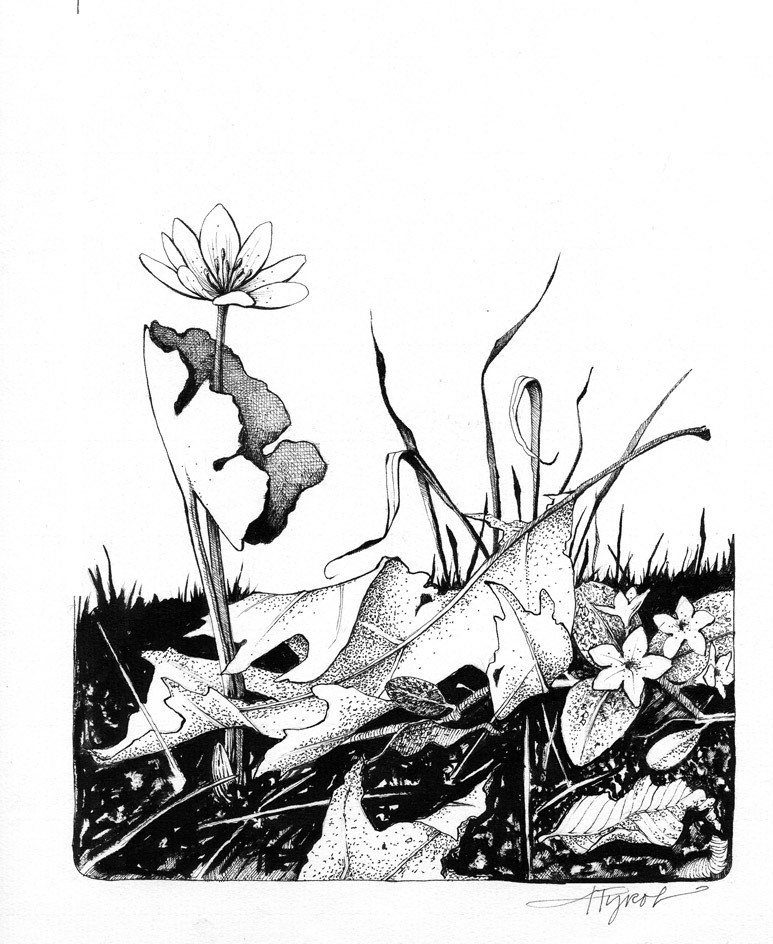
Spring wildflowers live hurried lives. They push out of the ground as soon as it begins to thaw, or soon afterwards, and then some of them disappear for the year – shrinking back into their underground root systems soon after the forest canopy closes.
They are blooming in the woods and alongside brooks and ponds right now, and there you will find the tiny, pink-streaked, white blossoms of spring beauties, the dark three-petaled flowers of red trilliums, the bright-white sunbursts of bloodroots, and the pale, white and yellow puffs of Dutchman’s breeches.
Some spring wildflowers are considered “ephemerals,” because they only photosynthesize for a few brief weeks before the forest leaves bring deep shade to the forest floor. After that, their blossoms quickly wither and disappear. With ephemerals, such as the trout lily, Dutchman’s breeches, and spring beauty, the plant itself virtually disappears by midsummer. So, April and May are the months to know and appreciate them.
Other wildflowers, like bloodroot, bloom in early spring but continue to grace the forest floor with their deeply lobed foliage year-round.
More than 150 years ago, Henry David Thoreau wrote eloquently in his journal of the splendor of these spring days. He studied the flowers of early spring and wrote often about them, mentioning in one entry: “I do not know that the woods are ever more beautiful, or affect me more.”
On an early April hike up Irish Hill, not far from my Montpelier home, I found this year’s first spring beauties – tiny pink-streaked white blossoms sprinkled across a dead brown hillside. There were bright green, wild leeks sprouting nearby, and the trees were just budding.
On the return, beside a brook, I found the egg-yellow composite blossoms of coltsfoot, a non-native flower, opening like miniature suns in the brook-side mud. There were red trilliums, too – “wake robins,” some people call them because of their springtime blooms. However, many in our region have smelled their faint, rotten-meat odor, which attracts pollinating insects and have given them the less delicate name of “Stinking Benjamins.”
In colder, higher locations throughout northern New England, the spring flower show continues into early June. One of my favorite finds was a stand of pink lady’s slipper (also called moccasin flower) during a hike on a trail in New Hampshire. I was walking beside a splashing brook in a high, cold valley in the White Mountains. At first, I saw one small, pink orchid, but then there was a bunch of two or three, then another bunch, and another. And then the forest floor was luxuriously dotted with dozens of pink blossoms in small patches. It was an enchanted grove, made more beautiful by my knowledge that all the exotic pink blossoms would be gone within a week or two.
Another time, as a friend and I descended Camel’s Hump at just the right time of year, we found miniature Zen garden-like arrangements of painted trilliums scattered on both sides of the trail. The flowers were growing randomly in the clearings of the subalpine forest, each plant’s three white petals striped with a single bright pink chevron.
Trout lilies are perhaps the emblematic spring ephemerals of northern New England. Anyone who walks in the woods at this time of year has seen them. Their little blossoms hang upside down like tiny, lemon-yellow bells. They are so small and delicate that you have to wonder how they survive. But they are, obviously, very successful at surviving. They spread more by expanding their root systems than by the seeds produced by their flowers – a strategy of many wildflowers.
In fact, trout lilies are more than just survivors. They are like explorers, entrepreneurs even. I’m sure of that because I have watched a small patch of them make a foothold and then establish themselves in numbers on my moist and shady front lawn. From a single plant a few years ago, they’ve expanded and prospered, and now there are a couple of dozen tiny lily blossoms on my lawn each spring – and new patches are appearing in other damp places on the thin grass.
Their seeds probably were carried here originally on the wind from one of the forested hills nearby. They’re doing fine now, probably expanding by producing small bulbs. Last month’s freak snowstorm dumped nearly a foot of wet snow on their first blossoms, but they didn’t seem to mind a bit. They are out there right now, blossoming vigorously in the bright May sunshine.


Discussion *